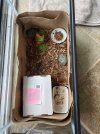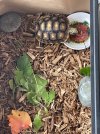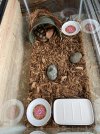Hello! I just adopted a red foot yesterday and trying to crash course how to best care for the little one. He/she is about 3 inches long and will be living in Kaneohe. My plan is to eventually let him live outdoors but for now he’s indoors to keep him safe from mongoose/rats. As I understood from a member of the group (thank you again for your help), the rf won’t need a lamp/uvb light as long as I can keep the enclosure temp in the 80s and let it roam outside for short amount when sun is out. I do have questions on how often it’s suppose to eat and how to prevent shell pyramiding. Any insights would be much appreciated. Thank you for your time and opinion. Here are some photos of Toto. (I know his space is too small but this is what he came with yesterday. Any suggestions for new enclosure also welcomed!)
You are using an out of date browser. It may not display this or other websites correctly.
You should upgrade or use an alternative browser.
You should upgrade or use an alternative browser.
New red foot owner on Oahu
- Thread starter Totoboo
- Start date
The_Four_Toed_Edward
Active Member
Have you read this?
 tortoiseforum.org
tortoiseforum.org
The key to avoid pyramiding is providing your tortoise with the right humidity and soaking them daily while they are still young.
Tortoises should eat daily and have the option to graze thorough the day. Any info on "starving days" is outdated and plain wrong.
Info For New People. Please Read This First.
Hello and welcome to tortoiseforum.org! We are all glad you are here! There is no other forum like this anywhere. We have tens of thousands of members from all over the world ranging from kids with their first tortoise to people who have been breeding and keeping high end tortoises since the...
The key to avoid pyramiding is providing your tortoise with the right humidity and soaking them daily while they are still young.
Tortoises should eat daily and have the option to graze thorough the day. Any info on "starving days" is outdated and plain wrong.
Have you read this?
Info For New People. Please Read This First.
Hello and welcome to tortoiseforum.org! We are all glad you are here! There is no other forum like this anywhere. We have tens of thousands of members from all over the world ranging from kids with their first tortoise to people who have been breeding and keeping high end tortoises since the...tortoiseforum.org
The key to avoid pyramiding is providing your tortoise with the right humidity and soaking them daily while they are still young.
Tortoises should eat daily and have the option to graze thorough the day. Any info on "starving days" is outdated and plain wrong
oh wow thanks for pointing me to that post and for your suggestions! I really appreciate it.Have you read this?
Info For New People. Please Read This First.
Hello and welcome to tortoiseforum.org! We are all glad you are here! There is no other forum like this anywhere. We have tens of thousands of members from all over the world ranging from kids with their first tortoise to people who have been breeding and keeping high end tortoises since the...tortoiseforum.org
The key to avoid pyramiding is providing your tortoise with the right humidity and soaking them daily while they are still young.
Tortoises should eat daily and have the option to graze thorough the day. Any info on "starving days" is outdated and plain wrong.
Alex and the Redfoot
Well-Known Member
Hello and welcome! Toto is very-very cute  )
)
1. High humidity (80-90%) is the key to prevent pyramiding. For a redfooted tortoise this is mandatory.
2. A shallow water dish (large enough to get into and soak a little) with clean fresh water should be always available. Terracotta saucers (used under plant pots) are cheap and safe. Water dish should be buried in substrate to ease getting in and out.
3. Daily soakings are required for baby redfoots. 30 minutes in a lukewarm water. Use an opaque container large enough to make some steps and turn around. Water should be kept warm at all times. You can do soakings in the morning and after outside walks to ensure hydration.
Feed him everyday, as much as he wants: place a food bowl and leave it till the end of the day. If he eats everything - put a bit more next day. In the evening only a little should be left.
His diet should be varied and can contain up to 50-60% fruit, 50-60% leafy greens and 10% animal protein. This proportion can vary depending on season. What to try:
1. Fruit: papaya, mango, cantaloupe, berries, squashes, watermelon, banana, guava, "prickly pear". Apples and pears without seeds. Any citrus - rare and only a little.
2. Leafy greens: hibiscus (both leaves and flowers), mulberry, young grape leaves, mallow, dandelions and alike.
3. Other: mushrooms (not wild-collected), up to 20-30%, instead of fruit.
4. Protein: hard-boiled egg, chicken breast (or any other low-fat meat boiled without salt), invertebrates (like earthworms, mealworms, superworms), high quality low-fat cat foods, shrimps. Protein is important for growing redfoots, he should get some at least once a week.
5. Supplements: calcium powder (a tiny pinch over greens 2 times a week). Desirable, but you can do without it: Mazuri 5M21 Tortoise Diet (a few pellets once-twice a week), MinerAll multivitamin powder (once a week).
Also, you can look at this care sheet: https://tortoiseforum.org/threads/redfoot-tortoise-care-sheet.175319/
Please, don't hesitate to ask more questions!
1. High humidity (80-90%) is the key to prevent pyramiding. For a redfooted tortoise this is mandatory.
2. A shallow water dish (large enough to get into and soak a little) with clean fresh water should be always available. Terracotta saucers (used under plant pots) are cheap and safe. Water dish should be buried in substrate to ease getting in and out.
3. Daily soakings are required for baby redfoots. 30 minutes in a lukewarm water. Use an opaque container large enough to make some steps and turn around. Water should be kept warm at all times. You can do soakings in the morning and after outside walks to ensure hydration.
Feed him everyday, as much as he wants: place a food bowl and leave it till the end of the day. If he eats everything - put a bit more next day. In the evening only a little should be left.
His diet should be varied and can contain up to 50-60% fruit, 50-60% leafy greens and 10% animal protein. This proportion can vary depending on season. What to try:
1. Fruit: papaya, mango, cantaloupe, berries, squashes, watermelon, banana, guava, "prickly pear". Apples and pears without seeds. Any citrus - rare and only a little.
2. Leafy greens: hibiscus (both leaves and flowers), mulberry, young grape leaves, mallow, dandelions and alike.
3. Other: mushrooms (not wild-collected), up to 20-30%, instead of fruit.
4. Protein: hard-boiled egg, chicken breast (or any other low-fat meat boiled without salt), invertebrates (like earthworms, mealworms, superworms), high quality low-fat cat foods, shrimps. Protein is important for growing redfoots, he should get some at least once a week.
5. Supplements: calcium powder (a tiny pinch over greens 2 times a week). Desirable, but you can do without it: Mazuri 5M21 Tortoise Diet (a few pellets once-twice a week), MinerAll multivitamin powder (once a week).
Also, you can look at this care sheet: https://tortoiseforum.org/threads/redfoot-tortoise-care-sheet.175319/
Please, don't hesitate to ask more questions!
This is amazing, thank you so much!Hello and welcome! Toto is very-very cute)
1. High humidity (80-90%) is the key to prevent pyramiding. For a redfooted tortoise this is mandatory.
2. A shallow water dish (large enough to get into and soak a little) with clean fresh water should be always available. Terracotta saucers (used under plant pots) are cheap and safe. Water dish should be buried in substrate to ease getting in and out.
3. Daily soakings are required for baby redfoots. 30 minutes in a lukewarm water. Use an opaque container large enough to make some steps and turn around. Water should be kept warm at all times. You can do soakings in the morning and after outside walks to ensure hydration.
Feed him everyday, as much as he wants: place a food bowl and leave it till the end of the day. If he eats everything - put a bit more next day. In the evening only a little should be left.
His diet should be varied and can contain up to 50-60% fruit, 50-60% leafy greens and 10% animal protein. This proportion can vary depending on season. What to try:
1. Fruit: papaya, mango, cantaloupe, berries, squashes, watermelon, banana, guava, "prickly pear". Apples and pears without seeds. Any citrus - rare and only a little.
2. Leafy greens: hibiscus (both leaves and flowers), mulberry, young grape leaves, mallow, dandelions and alike.
3. Other: mushrooms (not wild-collected), up to 20-30%, instead of fruit.
4. Protein: hard-boiled egg, chicken breast (or any other low-fat meat boiled without salt), invertebrates (like earthworms, mealworms, superworms), high quality low-fat cat foods, shrimps. Protein is important for growing redfoots, he should get some at least once a week.
5. Supplements: calcium powder (a tiny pinch over greens 2 times a week). Desirable, but you can do without it: Mazuri 5M21 Tortoise Diet (a few pellets once-twice a week), MinerAll multivitamin powder (once a week).
Also, you can look at this care sheet: https://tortoiseforum.org/threads/redfoot-tortoise-care-sheet.175319/
Please, don't hesitate to ask more questions!
Alex and the Redfoot
Well-Known Member
A quick note on the enclosure:
1. Get rid of paper, it won't last even for a week. If you want to cover glass sides - it should done from the outside.
2. Cardboard hide obviously won't last too A small opaque dark-colored plastic container (a dishwashing tub or from some food products) with an entrance cut on the side - will work. It should not be very large and tall. 6x6x4 inches or like that (enough space to turn around and tight to feel secure).
A small opaque dark-colored plastic container (a dishwashing tub or from some food products) with an entrance cut on the side - will work. It should not be very large and tall. 6x6x4 inches or like that (enough space to turn around and tight to feel secure).
3. Make a cover for the enclosure to keep humidity in. And if the glass tank is by the window - keep an eye on temperatures in tank. Get a cheap digital thermometer/hygrometer from the nearest hardware store to be informed about temperatures. It's really important. The enclosure is small and he has no way to find suitable microclimate there.
His new enclosure should be least 4x2x2 ft to last for a couple of years. It doesn't have to be a fancy terrarium - raised garden bed, food trough, portable greenhouse and so on can make a great enclosure.
1. Get rid of paper, it won't last even for a week. If you want to cover glass sides - it should done from the outside.
2. Cardboard hide obviously won't last too
3. Make a cover for the enclosure to keep humidity in. And if the glass tank is by the window - keep an eye on temperatures in tank. Get a cheap digital thermometer/hygrometer from the nearest hardware store to be informed about temperatures. It's really important. The enclosure is small and he has no way to find suitable microclimate there.
His new enclosure should be least 4x2x2 ft to last for a couple of years. It doesn't have to be a fancy terrarium - raised garden bed, food trough, portable greenhouse and so on can make a great enclosure.
Ok thanks for pointing all these things out; I have never taken care of a tortoise. Toto is grateful for all of you watching out for his wellbeing in the hands of this newbie 😅A quick note on the enclosure:
1. Get rid of paper, it won't last even for a week. If you want to cover glass sides - it should done from the outside.
2. Cardboard hide obviously won't last tooA small opaque dark-colored plastic container (a dishwashing tub or from some food products) with an entrance cut on the side - will work. It should not be very large and tall. 6x6x4 inches or like that (enough space to turn around and tight to feel secure).
3. Make a cover for the enclosure to keep humidity in. And if the glass tank is by the window - keep an eye on temperatures in tank. Get a cheap digital thermometer/hygrometer from the nearest hardware store to be informed about temperatures. It's really important. The enclosure is small and he has no way to find suitable microclimate there.
His new enclosure should be least 4x2x2 ft to last for a couple of years. It doesn't have to be a fancy terrarium - raised garden bed, food trough, portable greenhouse and so on can make a great enclosure.
Alex and the Redfoot
Well-Known Member
Good luck with him! I think he is in the good hands. Don't forget to post updates and more questions!
COmtnLady
Well-Known Member
Welcome to the forum!
My Redfoot is VERY social and loves watching what we do throughout our waking hours. She would feel deprived if she couldn't look out through the side of her enclosure.
The care sheets already mentioned are really good. (No sand in substrate, no moss, either can cause digestive tract impaction.)
A top to keep the humidity in is VERY important for Redfoots. Some of us use a tent or small plastic greenhouse, some build tops. Basically everybody adapts as needed. Mine is an actual lid that fits across the enclosure, with parts that can lift up for access to water dishes and such. (Where I live the ambient humidity is regularly between 9% and 30%, so here it needs to be a bit more enclosed than some other places to keep it at 80% humidity and 80 F degrees.)
Yours is young enough to need daily soaks, and it doesn't hurt to continue them even when older. Put just enough warm water in to come up to where the top and bottom parts of the shell come together (these aren't aquatic turtles, so don think they can swim) it needs to be shallow enough for them to easily keep their head above water.
Keep an eye on the temp of the water. It gets cold really fast and needs to be warmed up frequently.
Bigger is better insofar as the enclosure is concerned. There are lots of topics on the forum about how to build ones, or which commercially made ones are ok. RFs grow fairly quickly, so opt for for more space.
Re: the rats and mongoose(s) - Tortoise aren't very fast (unless you turn your back when outside, but that's another story), so you'll need to make sure those critters can't get anywhere near your Tortoise ever. We've all seen sad situations where a dog or rat or whatever really tore-up, maimed, or killed a tortoise that had no way to defend itself or nowhere to get away from the attacker. Be aware of birds swooping into an uncovered outdoor enclosure, too. Plus, ants or other insects can get to them.
Try any produce you would eat on your Tortoise (no onions or their relatives, and I don't offer mine cabbage or broccoli, but maybe some of the more experienced RF keepers would have other opinions, let's ask). Mine loves blueberries, strawberries, raspberries, mushrooms, and bananas, Radicchio, Lacinato Kale, lots of variety in green leafy plants, yellow tomatoes, mangos. I try to get different colors into her diet for the nutrients in them. I put a little ReptiCal on her berries or bananas a couple times a week ("little" means barely touch a side of each blueberry to the surface of the calcium so there is only a small dot of white on it no bigger than a pencil eraser). And I use mealworms for protein source.
Amount-wise: the "rule of thumb" is envision the tort's shell as a bowl and feed that much, every day. If it gets eaten "in no time" your tort is hungry and needs more, if a lot gets left, adjust downwards. I leave it in until the next day's feeding because she will come back whenever the mood strikes and eat some more.
'Glad you found here! Keep sharing pics and the adventure of having such a cool creature around!
.
My Redfoot is VERY social and loves watching what we do throughout our waking hours. She would feel deprived if she couldn't look out through the side of her enclosure.
The care sheets already mentioned are really good. (No sand in substrate, no moss, either can cause digestive tract impaction.)
A top to keep the humidity in is VERY important for Redfoots. Some of us use a tent or small plastic greenhouse, some build tops. Basically everybody adapts as needed. Mine is an actual lid that fits across the enclosure, with parts that can lift up for access to water dishes and such. (Where I live the ambient humidity is regularly between 9% and 30%, so here it needs to be a bit more enclosed than some other places to keep it at 80% humidity and 80 F degrees.)
Yours is young enough to need daily soaks, and it doesn't hurt to continue them even when older. Put just enough warm water in to come up to where the top and bottom parts of the shell come together (these aren't aquatic turtles, so don think they can swim) it needs to be shallow enough for them to easily keep their head above water.
Keep an eye on the temp of the water. It gets cold really fast and needs to be warmed up frequently.
Bigger is better insofar as the enclosure is concerned. There are lots of topics on the forum about how to build ones, or which commercially made ones are ok. RFs grow fairly quickly, so opt for for more space.
Re: the rats and mongoose(s) - Tortoise aren't very fast (unless you turn your back when outside, but that's another story), so you'll need to make sure those critters can't get anywhere near your Tortoise ever. We've all seen sad situations where a dog or rat or whatever really tore-up, maimed, or killed a tortoise that had no way to defend itself or nowhere to get away from the attacker. Be aware of birds swooping into an uncovered outdoor enclosure, too. Plus, ants or other insects can get to them.
Try any produce you would eat on your Tortoise (no onions or their relatives, and I don't offer mine cabbage or broccoli, but maybe some of the more experienced RF keepers would have other opinions, let's ask). Mine loves blueberries, strawberries, raspberries, mushrooms, and bananas, Radicchio, Lacinato Kale, lots of variety in green leafy plants, yellow tomatoes, mangos. I try to get different colors into her diet for the nutrients in them. I put a little ReptiCal on her berries or bananas a couple times a week ("little" means barely touch a side of each blueberry to the surface of the calcium so there is only a small dot of white on it no bigger than a pencil eraser). And I use mealworms for protein source.
Amount-wise: the "rule of thumb" is envision the tort's shell as a bowl and feed that much, every day. If it gets eaten "in no time" your tort is hungry and needs more, if a lot gets left, adjust downwards. I leave it in until the next day's feeding because she will come back whenever the mood strikes and eat some more.
'Glad you found here! Keep sharing pics and the adventure of having such a cool creature around!
.
Although Redfoots are not aquatic turtles, they can certainly swim, and do so in their natural habitat when it's necessary. But they should never be left in deep water or even in shallow water by themselves as they may flip over and drown. All baby tortoises need hourly soaks or at least 30 minutes warm water soaks every day, to ensure good hydration. The water level should be up to where the top and bottom shells meet.
Welcome!
- Joined
- Jul 16, 2014
- Messages
- 29,175
- Location (City and/or State)
- South Eastern Florida (U.S.A.)/Rock Hill S.C.
Hello and welcome to the forum from South Florida
Thank you for your insights! I am trying to absorb everything like a sponge. I really appreciate your help.Welcome to the forum!
My Redfoot is VERY social and loves watching what we do throughout our waking hours. She would feel deprived if she couldn't look out through the side of her enclosure.
The care sheets already mentioned are really good. (No sand in substrate, no moss, either can cause digestive tract impaction.)
A top to keep the humidity in is VERY important for Redfoots. Some of us use a tent or small plastic greenhouse, some build tops. Basically everybody adapts as needed. Mine is an actual lid that fits across the enclosure, with parts that can lift up for access to water dishes and such. (Where I live the ambient humidity is regularly between 9% and 30%, so here it needs to be a bit more enclosed than some other places to keep it at 80% humidity and 80 F degrees.)
Yours is young enough to need daily soaks, and it doesn't hurt to continue them even when older. Put just enough warm water in to come up to where the top and bottom parts of the shell come together (these aren't aquatic turtles, so don think they can swim) it needs to be shallow enough for them to easily keep their head above water.
Keep an eye on the temp of the water. It gets cold really fast and needs to be warmed up frequently.
Bigger is better insofar as the enclosure is concerned. There are lots of topics on the forum about how to build ones, or which commercially made ones are ok. RFs grow fairly quickly, so opt for for more space.
Re: the rats and mongoose(s) - Tortoise aren't very fast (unless you turn your back when outside, but that's another story), so you'll need to make sure those critters can't get anywhere near your Tortoise ever. We've all seen sad situations where a dog or rat or whatever really tore-up, maimed, or killed a tortoise that had no way to defend itself or nowhere to get away from the attacker. Be aware of birds swooping into an uncovered outdoor enclosure, too. Plus, ants or other insects can get to them.
Try any produce you would eat on your Tortoise (no onions or their relatives, and I don't offer mine cabbage or broccoli, but maybe some of the more experienced RF keepers would have other opinions, let's ask). Mine loves blueberries, strawberries, raspberries, mushrooms, and bananas, Radicchio, Lacinato Kale, lots of variety in green leafy plants, yellow tomatoes, mangos. I try to get different colors into her diet for the nutrients in them. I put a little ReptiCal on her berries or bananas a couple times a week ("little" means barely touch a side of each blueberry to the surface of the calcium so there is only a small dot of white on it no bigger than a pencil eraser). And I use mealworms for protein source.
Amount-wise: the "rule of thumb" is envision the tort's shell as a bowl and feed that much, every day. If it gets eaten "in no time" your tort is hungry and needs more, if a lot gets left, adjust downwards. I leave it in until the next day's feeding because she will come back whenever the mood strikes and eat some more.
'Glad you found here! Keep sharing pics and the adventure of having such a cool creature around!
.
Thank you for this tip 😃Although Redfoots are not aquatic turtles, they can certainly swim, and do so in their natural habitat when it's necessary. But they should never be left in deep water or even in shallow water by themselves as they may flip over and drown. All baby tortoises need hourly soaks or at least 30 minutes warm water soaks every day, to ensure good hydration. The water level should be up to where the top and bottom shells meet.
Hello and thank you 😊Hello and welcome to the forum from South Florida
Thank you 😊Welcome!
Thank you and will do 😊Wow - he is quite stunningly handsome !!! And extremely cute too - I do hope you will post lots of photos of his progress, as everyone here loves photos !
Very best wishes from Angie in the UK
Alex and the Redfoot
Well-Known Member
Thanks for the update! You can cut an entrance on the side of this plastic pot - this will make a more secure (for him) and more humid hide.




